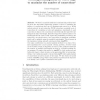Free Online Productivity Tools
i2Speak
i2Symbol
i2OCR
iTex2Img
iWeb2Print
iWeb2Shot
i2Type
iPdf2Split
iPdf2Merge
i2Bopomofo
i2Arabic
i2Style
i2Image
i2PDF
iLatex2Rtf
Sci2ools
STACS
2007
Springer
2007
Springer
Wavelength Management in WDM Rings to Maximize the Number of Connections
Abstract. We study computationally hard combinatorial problems arising from the important engineering question of how to maximize the number of connections that can be simultaneously served in a WDM optical network. In such networks, WDM technology can satisfy a set of connections by computing a route and assigning a wavelength to each connection so that no two connections routed through the same fiber are assigned the same wavelength. Each fiber supports a limited number of w wavelengths and in order to fully exploit the parallelism provided by the technology, one should select a set connections of maximum cardinality which can be satisfied using the available wavelengths. This is known as the maximum routing and path coloring problem (maxRPC). Our main contribution is a general analysis method for a class of iterative algorithms for a more general coloring problem. A lower bound on the benefit of such an algorithm in terms of the optimal benefit and the number of available wavel...
Available Wavelengths | Coloring Problem | STACS 2007 | Theoretical Computer Science | WDM Optical Network |
| Added | 09 Jun 2010 |
| Updated | 09 Jun 2010 |
| Type | Conference |
| Year | 2007 |
| Where | STACS |
| Authors | Ioannis Caragiannis |
Comments (0)

